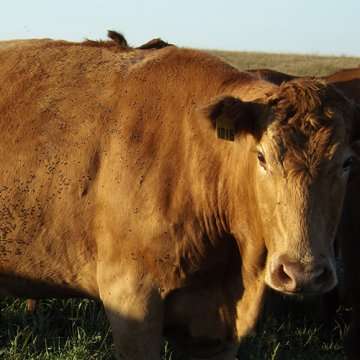
Face and horn flies got the upper hand one summer at Linda Simmons’ ranch near Twin Brooks, South Dakota. It happened despite two years of feeding insecticide in the cows’ mineral.
The swarming flies spread pinkeye to some 70 calves and 15 cows, all receiving a prophylactic antibiotic to prevent worsening conditions. “The treatment cost was around $5,000,” she says.
She also began to consider that insecticide residues in cattle manure were harming the dung beetles and other beneficial insects. Dung beetles help control flies by feeding on manure patties, thus, destroying flies’ breeding ground.
NONCHEMICAL OPTIONS TO EXPLORE
Searching for nonchemical control options, Simmons developed a Sustainable Agriculture Research and Education (SARE) grant project (projects.sare.org/sare_project/fnc14-977/) to experiment with nonchemical fly-control systems that would also have the effect of conserving beneficial insects.
Her first step was to implement rotational grazing, a practice known to thwart flies since cattle are frequently moved. Simmons cross-fenced her 335 acres of main pasture into eight paddocks.
Then, working with her neighbor, a sheep producer, she tested an Nzi flexible-cloth fly trap. “We found this trap does trap stable flies and the blow flies that can be so hard on sheep,” she says.
It is an old-fashioned walk-through fly trap Simmons tried at her own ranch that is doing a good job of controlling face and horn flies in her cattle. “It’s so easy,” she says.
Measuring about 10 feet in length, the walk-through fly trap is constructed with a solid top and partially solid sides to create a dim interior. As cattle pass through the trap, strips of canvas or old carpet dislodge flies from the animals. The dislodged flies are drawn to the light at the bottom of the trap coming through louvered screens. The flies become trapped in the screened areas.
Designed in the 1930s by entomologist Willis Bruce, the trap was tested in Missouri in the 1980s and again in the 1990s. Both tests achieved horn fly control of 50% and 40%, respectively. Horn flies were maintained below the economic threshold of 200 flies per animal.
The fly trap achieved similar control in Simmons’ herd. The first two years she walked cattle through the trap when the fly population was large enough to number about 200 flies per cow.
“I used it six times the first year,” she says. “After passing through the trap, the cows had hardly any flies on them.”
The third year of using the trap, in 2017, the fly population was so diminished, she used it only twice. Simmons credits the trap with playing a role in the smaller number of flies. “Weather could be a factor, too,” she says.
Routine monitoring of fly populations tells Simmons when cattle need to pass through the trap.
“I learned that counting the flies or making some kind of measurement is the only way to know if something might be working – whether it’s a pesticide, a management practice, or a fly trap,” she says. “Rather than waiting for clouds of horn flies to appear, the fly counts tell me when to take action before the animals are troubled.”
Hand in hand with fewer flies has come a drop in pinkeye cases. “Last year, we treated only one calf for pinkeye,” Simmons says.
To walk the cattle through the trap, she positions the trap so it provides the exit from a corral. Simmons lets the cattle find their own way out of the trap. With some hesitation the first time, the cattle walk through readily in subsequent treatments.
“I didn’t have the brushes installed on the inside of the trap because the canvas strips make it easier for the cattle to take themselves through, especially the first few times,” Simmons explains. “The trap actually works pretty well without the brushes.”
She had her walk-through fly trap built according to a blueprint available from the University of Missouri Extension (extension2.missouri.edu/mx1904c6). Construction costs came to $811 for material and $3,000 for labor. Modifications, Simmons says, could possibly reduce the costs.
INCREASE IN DUNG BEETLES
The natural fly control has led to more dung beetles in her pastures. By monitoring the rate of dung decomposition, Simmons learned that the feeding activity of the increased number of dung beetles is causing manure patties to decompose as quickly as within 10 days.
“Dung disappearance means both higher soil fertility and fewer parasites and pests,” she says. “The profits from my pasture depend on the decomposition of dung. Of the nutrients consumed by livestock, 90% are deposited as dung, which must be broken down and decomposed in order to provide forage plants with the nutrients needed to regrow. Forage production in pastures is often limited by nutrients, which can be tied up in undecomposed manure.”

